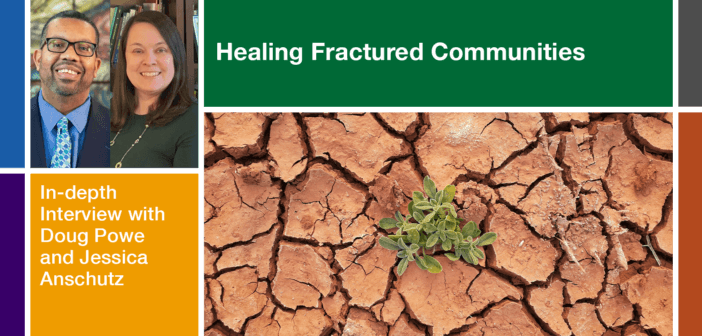How can congregational leaders be healers and agitators at the same time? In this in-depth interview, Doug Powe and Jessica Anschutz reflect on the new book Healing Fractured Communities and the stories of pastoral leaders engaged in the work of renewal, resilience, and resistance in congregations, on college campuses, and in communities.
Listen to this interview, watch the interview video on YouTube, or continue reading.
Ann Michel: Doug, you and Jessica have pulled together a new book Healing Fractured Communities. Can you explain a little bit about this book, how it came to be, and who’s been part of the process?
Doug Powe: Absolutely. This book grew out of a Lewis Center program called the Lewis Community Leadership Fellows which was funded through a grant from the Lilly Endowment Inc. This program created a series of leadership development cohorts designed to help clergy leaders better engage their communities, to think about and deeply engage a context, and to collaborate with different individuals in their communities like civic leaders, business leaders, and others who are critical for the work of the church. Over several years we worked with eight cohorts of Community Fellows.
As we got near the end of the project, the idea of the book came about to capture some of the really powerful work that was being done by these fellows. It wasn’t possible to have every single fellow share their story, so we worked with six fellows who serve in a variety of contexts ranging from rural to a college ministry to your typical urban or suburban settings. Both Jessica and I found working with these fellows fun and exciting, and they did excellent work.
Ann Michel: Jessica, could you expand a bit on the different ministry contexts of the six contributing authors and say a bit about the specific situations they address in this book?
Jessica Anschutz: Each of the authors is serving as United Methodist clergy, and they serve in a variety of different contexts. One author serves a congregation that’s on the border between the United States and Mexico. She talks about her work moving the congregation beyond the walls of the church and across the border. A couple of the authors are in suburban contexts. One writes about her ministry in Arkansas and Maryland in congregations struggling to see the poor in their midst. Another author is serving in a rural context in Missouri. We have one who’s serving in a multicultural, multiracial appointment in New Jersey, and another of the pastors serves in campus ministry. While we don’t cover all possible contexts, we cover a range of contexts in the book.
Ann Michel: Doug, could you say a bit about how you chose the theme “healing fractured communities” not just for the book but for the overall work of the Lewis Community Leadership Fellows?
Doug Powe: For several years each cohort of fellows had one of their meetings in Baltimore, which like any major city was experiencing racial tension. When in Baltimore, they had the opportunity to talk with pastors, police officers, and elected officials. They focused on the issue of racial tension and the fractures caused in a major city, and how we as church leaders can help. This led to the articulation of the theme of healing fractured communities. As the fellows looked at other community issues, such as education and housing, the same theme emerged. As we thought about the book, we wanted to capture how leaders saw fractures in their own communities and how they could address them in ways that bring healing or help. Racial tension, public education, affordable housing — these are of course huge social issues. We realized you’re not going to solve them easily. However, the hope is that the church can bring healing or be a balm in these various situations. So, the book addresses how churches can create healing in the context of different types of community divisions.
Ann Michel: Is there one particular story or vignette from this book that really resonated with you personally, Jessica?
Jessica Anschutz: There are aspects of each story that resonated with me and my experiences in ministry. I would lift up a story from chapter 2 where Julius Wardley writes about his experience in campus ministry and engaging with college students who are experiencing poverty. He tells a story about Food for Thought, a Wesley Foundation food bank. He carried her groceries to the car so that he “could get to know her better.” He saw that her car was overflowing with trash bags filled with her personal belongings and that she was working hard to make a better life for herself and her children. I served in campus ministry for four years and this story reminded me of so many people I encountered, both on a college campus and in the churches that I served. Often when we build relationships with people, we learn that there is more happening in their lives under the surface than what is presented initially. We learn about their challenges and their vulnerabilities. As we develop those relationships, we are better able to respond and begin to take steps toward healing.
Ann Michel: How about you, Doug?
Doug Powe: First, I want to add to the story Jessica just shared. One helpful aspect of that chapter is that Julius talks about how congregations can partner or play an important role in healing the fracture of poverty in campus communities. This issue often flies under the radar for most of us because we just assume that when you’re in college you have housing and food. The reality of the situation though is that this is just not true. I really appreciated that story as well.
But the story I was struck by is that of Rev. Iraida Ruiz de Porras who is a female pastor in a multicultural setting. She shares in a compelling way the challenges of multicultural ministry. Many people talk about the importance of multicultural ministry and wanting to do this sort of work, but she really opens our eyes to just how difficult it can be. It is not easy to get congregations that have been brought up in different traditions to really share a space together and to worship their one Christian God together in a manner where they all feel filled by the Spirit. Near the end of Iraida’s chapter, she talks about a hymn sing that created space for them to come together where both congregations felt appreciated and could appreciate one another. It didn’t solve all the problems, but the hymn sing created that space where they could find a way to worship together. It was really touching.
Ann Michel: I’m glad you highlighted that example because it reminds me that among these stories are accounts of healing divides within congregations, not just divides between the congregation and the community. Doug, could you describe the key concepts of resilience, resistance, and renewal, which you identify as common threads that run though these various stories?
Doug Powe: We believe these “three R’s” are important to the ministry of any leader, particularly those in congregations. First, resilience. It is critically important that a leader helps the congregation to be resilient in the face of whatever challenges they are facing, particularly today coming out of COVID. Congregations might be in decline or facing other transitions. It takes a certain leadership to help the congregation be resilient in the face of those challenges. Second, renewal. Often that term is used in the context of congregational renewal but we’re thinking about it more in the Romans 12:2 way of “renewing your mind.” Congregations have to create a different mindset. You can’t just be a standalone entity as we often thought of ourselves in the past. Collaborations are necessary. Renewal is really about that different mindset.
Resistance probably is the one that seems different, but resistance is key. Part of the work of a congregation is resisting evil powers and resisting those things that can create fractures in the community. That resistance is critical for the work of healing. Empowering people to have the courage for resistance is important.
Ann Michel: The story about the congregation in the U.S.-Mexican border town makes the point that resistance doesn’t necessarily mean coming to blows. Small, strategic acts of resistance can also help a congregation heal. Even though the various chapters in this book address such different contexts and different challenges, there were common themes and common lessons that emerged. Jessica, could you name a couple of those key learnings?
Jessica Anschutz: One is the importance of building relationships within the congregational context, within the community, and beyond — whether it’s the person sitting next to you in the pew, the people who are coming to the food pantry, or those who live across the border in Mexico. That small step of learning someone’s name can be the starting point of a relationship that can begin to transform the community. Another key takeaway for me is that each of these leaders understood themselves to not only be a leader and a teacher but also a student. They were coming alongside and learning. That understanding promotes mutuality within these relationships. Perhaps my favorite theme is the importance of attending to the elephant in the room and understanding that sometimes what appears on the surface can be indicative of deeper issues. For example, Iraida points out that resistance to multilingual and bilingual worship services can be rooted in injustice, prejudice, and discrimination. Naming the elephant in the room is part of the painful and hard work of truth telling and a necessary step toward healing in congregations and in ministry.
Ann Michel: This book highlights the experiences of pastors who’ve taken part in the Lewis Community Leadership Fellows Program. Could you say a word to people who might be interested in our Lewis Fellows learning experiences?
Doug Powe: Absolutely. The Lewis Fellows initiative has been a critical part of the Lewis Center’s mission over the years. The program has helped hundreds of pastors develop critical leadership skills. Many of them are doing wonderful work not only in the United Methodist Church but across denominations. We actually just started a new Lewis Fellows cohort and it’s off to a great start. Going forward, the Lewis Center itself is funding this program. All the proceeds from the book Healing Fractured Communities are going towards continuing that program. When you purchase a book, you’re actually helping pastors develop their leadership skills.
Related Resources
- 4 Key Characteristics of Missional Congregations by Doug Powe
- Sustaining While Disrupting featuring Doug Powe and Lovett Weems — Leading Ideas Talks podcast episode | Podcast video | In-depth interview
- Listening to Your Community by Paul Nixon







